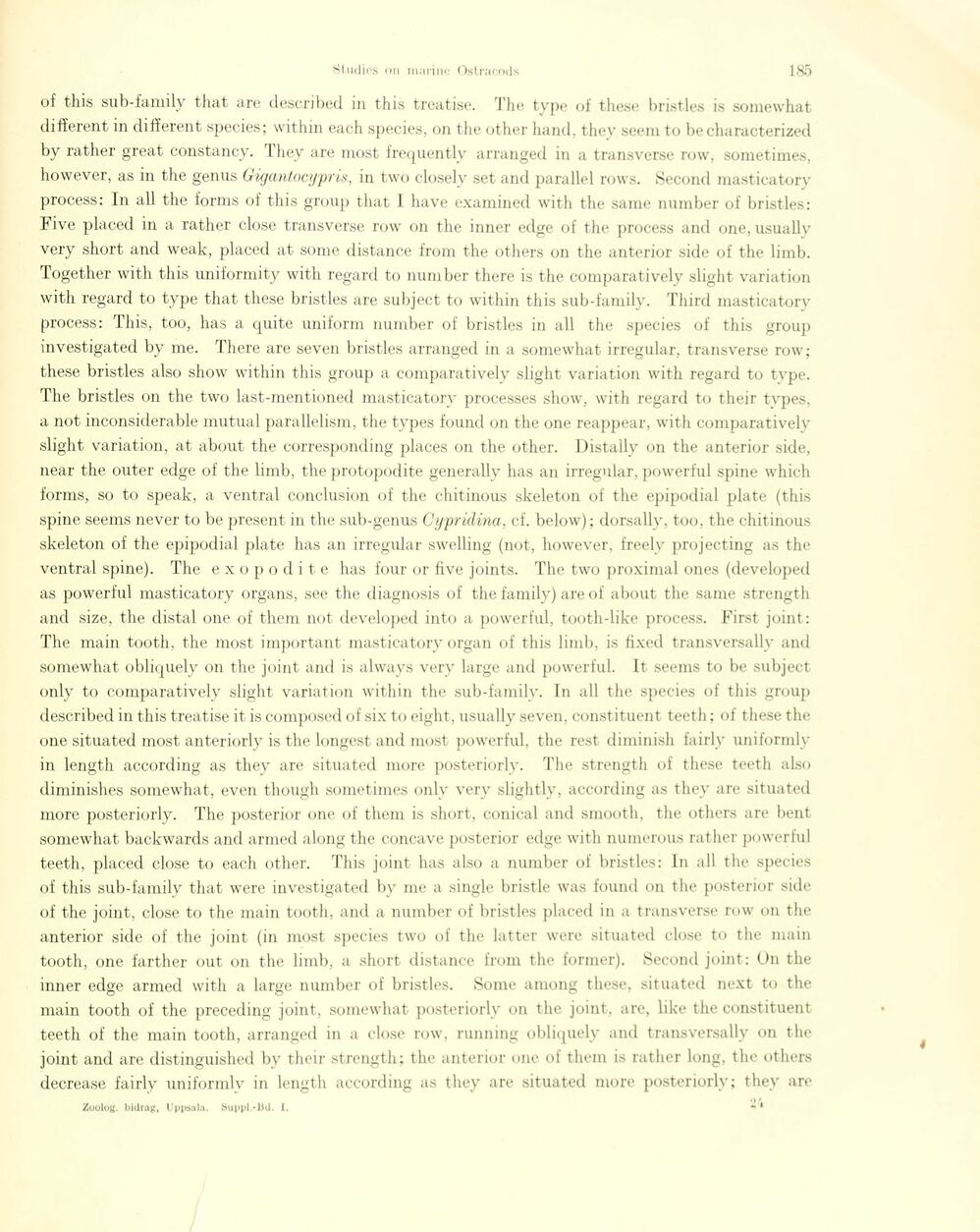
Full resolution (JPEG) - On this page / på denna sida - Sidor ...

<< prev. page << föreg. sida << >> nästa sida >> next page >>
Below is the raw OCR text
from the above scanned image.
Do you see an error? Proofread the page now!
Här nedan syns maskintolkade texten från faksimilbilden ovan.
Ser du något fel? Korrekturläs sidan nu!
This page has never been proofread. / Denna sida har aldrig korrekturlästs.
of this sub-family that are described in this treatise. The tvrpe of these bristles is somewhat
different in different species; within each species, on the other hand, they seem to becharacterized
by rather great constancy. 1 .hey are most frequently arranged in a transverse row, sometimes.
however, as in the genus Gigantocypris, in two closely set and parallel rows. Second masticatory
process: In all the forms of this group that I have examined with the same number of bristles:
Five placed in a rather close transverse row on the inner edge of the process and one, usually
very short and weak, placed at some distance from the others on the anterior side of the limb.
Together with this uniformity with regard to number there is the comparatively slight variation
with regard to type that these bristles are subjeet to within this sub-family. Third masticatory
process: This, too, has a quite uniform number of bristles in all the species of this group
investigated by me. There are seven bristles arranged in a somewhat irregulär, transverse row;
these bristles also show within this group a comparatively slight variation with regard to tvpe.
The bristles on the two last-mentioned masticatory processes show, with regard to their tvpes,
a not inconsiderable mutual parallelism, the types found on the one reappear, with comparatively
slight variation, at about the corresponding places on the other. Distallv on the anterior side,
near the outer edge of the limb, the protopodite generally has an irregulär, powerful spine which
forms, so to speak, a ventral conclusion of the chitinous skeleton of the epipodial plate (this
spine seems never to be present in the sub-genus Cypridina, cf. below); dorsally, too, the chitinous
skeleton of the epipodial plate has an irregulär swelling (not, however, freely projeeting as the
ventral spine). The exopodite has four or five joints. The two proximal ones (developed
as powerful masticatory organs, see the diagnosis of the family) are of about the same strength
and size, the distal one of them not developed into a powerful, tooth-like process. First joint:
The main tooth, the most important masticatory organ of this limb, is fixed transversally and
somewhat obliquely on the joint and is always very large and powerful. It seems to be subjeet
only to comparatively slight variation within the sub-family. In all the species of this group
described in this treatise it is composed of six to eight, usually seven, constituent teeth ; of these the
one situated most anteriorly is the longest and most powerful, the rest diminish fairly uniformly
in length according as they are situated more posteriorly. The strength of these teeth also
diminishes somewhat, even though sometimes only very slightly, according as they are situated
more posteriorly. The posterior one of them is short, conical and smooth, the others are bent
somewhat backwards and armed along the concave posterior edge with mimerons rather powerful
teeth, placed close to each other. This joint has also a number of bristles: In all the species
of this sub-family that were investigated by me a single bristle was fourni on the posterior side
of the joint, close to the main tooth, and a number of bristles placed in a transverse row on the
anterior side of the joint (in most species two of the latter were situated close to the main
tooth, one farther out on the limb, a short distance from the former). Second joint: Un the
inner edge armed with a large number of bristles. Some among these, situated next to the
main tooth of the preceding joint, somewhat posteriorly on the joint, are, like the constituent
teeth of the main tooth, arranged in a close row, running obliquely and transversally on the
joint and are distinguished by their strength; the anterior one of them is rather long, the others
decrease fairly uniformlv in length according as they are situated more posteriorly; they are
<< prev. page << föreg. sida << >> nästa sida >> next page >>